Two Hundred Years of Scottish Enterprise
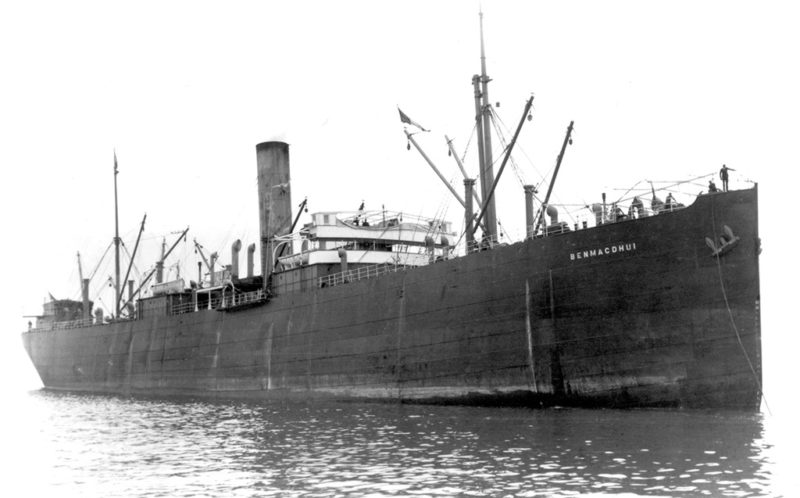
Ben Line has existed in one form or another for two hundred years since the brothers Alexander Thomson (1795-1880) and William Thomson (1806-1889) formed a shipbroking business in Leith in 1820. Napoleon Bonaparte died only a year later as a prisoner on the distant island of St. Helena to finally end the Napoleonic Wars era. The Thomson brothers had the ‘will to win’ as did Napoleon on the battlefield, with their wooden ships of that era having most of their running repairs done at their base at Leith. After a hundred years of worldwide shipping and trading, Ben Line Steamers Ltd. was set up in 1919 as a major shipping company owned largely by the Thomson family of Leith and the Mitchell family of Alloa. After the last ships were sold off in 1992, Ben Line Agencies Ltd. was set up and currently has two thousand employees in 110 offices throughout Asia operating in the four Agency areas of Port Agency, Liner Agency, Offshore Support and Project Logistics.
THE FIRST ONE HUNDRED YEARS
The sister of the two founding Thomson brothers, Jemima Thomson, married Thomas Henderson, an older brother of Patrick Henderson. The trade of the Thomson brothers at this time was one of marble cutting and merchants of Carrara white marble from the extensive mines in the Gulf of La Spezia in Italy. They imported Carrara white marble from nearby Livorno with help from Thomas Henderson, and their uncle, another Alexander Thomson, the owner of the Leith Marble Works. The first ship in 1839 was the barque Carrara of 218 grt, built at Limekilns and used on the route between Livorno and Leith to import white marble for the fine new buildings being constructed in Edinburgh at the time. The white marble business began to slowly decline, and the Thomson brothers purchased for the large sum at that time of £3,500 Australia of 388 grt, built in 1825 by William Wright of Newcastle for Tyneside owners. She was used on the North Atlantic trade, carrying Alloa coal to Canada, and returning with timber to Leith, but was lost on Sable Island on the approaches to the St. Lawrence river in January 1841.
The Alloa Coal Company owned by William Mitchell continued as a major part of Ben Line cargoes for the next one hundred years, with several sailing ships purchased in the 1840s that had been built in Canada e.g. Joanna of 555 grt, Wanderer of 686 grt and Signet of 505 grt. In 1847, Alexander Thomson retired from the business partnership, and William Thomson & Company of Leith was formed. The trade to Canada increased with coal outward from the Forth and Ayrshire ports, and new Canadian built ships carrying a full cargo of timber were auctioned off at their British or Continental destination at the end of their maiden voyages.
The sailing ship Araby Maid of 365 grt was built by Menzies & Company of Leith in 1851 and made an exploratory voyage to the Far East ports of Singapore, China and Japan in 1859, returning homeward with a cargo of nitrate loaded on the West coast of South America via Cape Horn. William Thomson II entered the partnership in 1860 followed by his brother James Wishart Thomson two years later. The iron sailing ship James Wishart of 796 grt, built at Leith in 1864 by S. & H. Morton, was one of nine sailing ships built in the 1860s for the longer and more profitable routes to Australia and the Far East. A base was established at Singapore for the China tea trade from ports in China such as Amoy. The sailing ships Wanderer and Joanna were both lost in 1864 in the Canadian trade. Canadian timber imports began to fall off in 1867 due to the imposition of a tax. However, Thomson sailing ships continued to trade to the St. Lawrence until the mid-1880s, and the last trio of ships lost in this trade were Algiers and Adriatic in 1882 and Vicksburg in 1884.
The first brig rigged iron steamship Benledi of 1,557 grt was built by Barclay, Curle & Company at their Clydeholm yard in 1871. She had an overall length of 275.0 feet, moulded beam of 32.0 feet, moulded depth of 24.0 feet, and was powered by a compound steam engine and a single screw. Sails were hoisted on both masts to augment her progress in favourable wind conditions or if the engine had broken down. She had two decks, and a round trip to the Far East took seven or eight months in those days.
Two fine new sailing ships were delivered in 1875 as the sisters Benan and Bencleuch, the last new sailing ships to be built for the Thomsons. Several second-hand sailing ships were however purchased after this date for the Canadian trade. The second steamer Benarty of 1,724 grt was delivered in 1876 by the Barclay, Curle yard to give a fleet of two steamers and a dozen sailing ships.
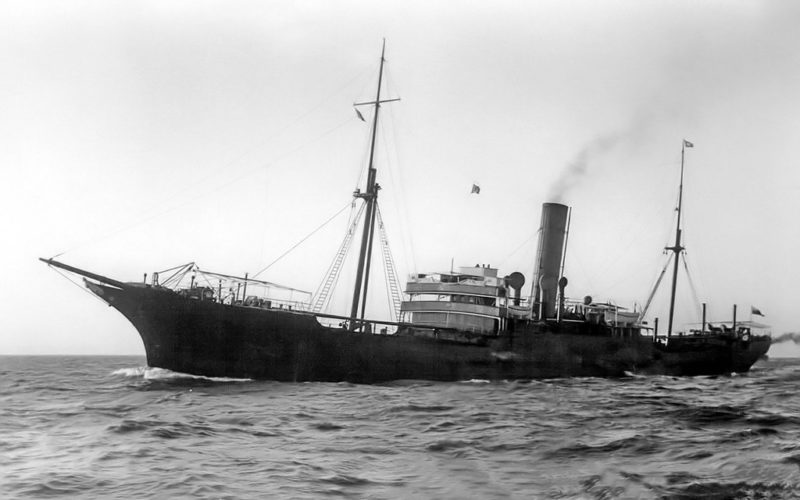
A new trade to the Baltic was inaugurated in 1878 by the sailing ship Bencleuch, and later by the steamers Petersburg, Stirling, Czar, Moscow, Reval and Cronstadt to the Gulf of Bothnia and St. Petersburg in Russia. A subsidiary company, the Leith & St. Petersburg Steam Shipping Company was set up in 1889 to own the ships employed on this seasonal trade as the Baltic is closed to shipping for several months in winter due to ice. The ships employed on it were switched to the Mediterranean trades in winter.
William Thomson & Company in 1879 joined the early forerunner of the Far East Freight Conference (FEFC) along with P. & O., Alfred Holt & Company, Castle Line and Glen & Shire Lines. This was the brainchild of John Swire although he had been influenced by the Calcutta Conference of 1875. John Swire was a major shareholder of the Ocean Steam Shipping Co. Ltd. (Blue Funnel Line formed in 1865) and formed his own China Navigation Co. Ltd. in 1872. In Pre-Conference years, Ben Line would sail from the West coast ports of Liverpool and Glasgow as well as their traditional East Coast ports, but this was then naturally restricted by Conference to Blue Funnel Line (Alfred Holt & Company) on the West coast, and Ben Line on the East Coast. Leith later became less used as a loading port, as the cargo came mostly from the industrial ports of Newcastle, Middlesbrough, Hull, London and Antwerp and other Continental ports.
By 1939, there were eighteen members of the important FEFC, who restricted membership of newer shipping companies e.g. Mitsui Line of Japan (admitted later when they joined with OSK of Japan), and Maersk Line of Denmark (admitted later with very limited rights from Genoa). These eighteen members were as follows:-
Great Britain (6) P.& O., Blue Funnel Line, Glen Line, Ben Line, Ellerman & Bucknall Line and Blue Star Line
Japan (2) NYK and OSK Lines
France (2) Messageries Maritimes and Chargeurs Reunis
Germany (2) Hapag and Norddeutsher Lloyd
Holland (2) Nederland Line and Rotterdam Lloyd
Denmark (1) East Asiatic Company
Norway (1) Wilhelm Wilhelmsen
Sweden (1) Brostrom
Italy (1) Lloyd Triestino
The Leith fleet of William Thomson & Company in 1880 numbered four steamers and ten sailing ships, four of which were large enough to be used in the Far East tea trades if necessary. The clipper ships would race home with the first crop of China tea, whereas Ben Line carried second grade teas in much larger quantities for a slower and safer voyage homewards.
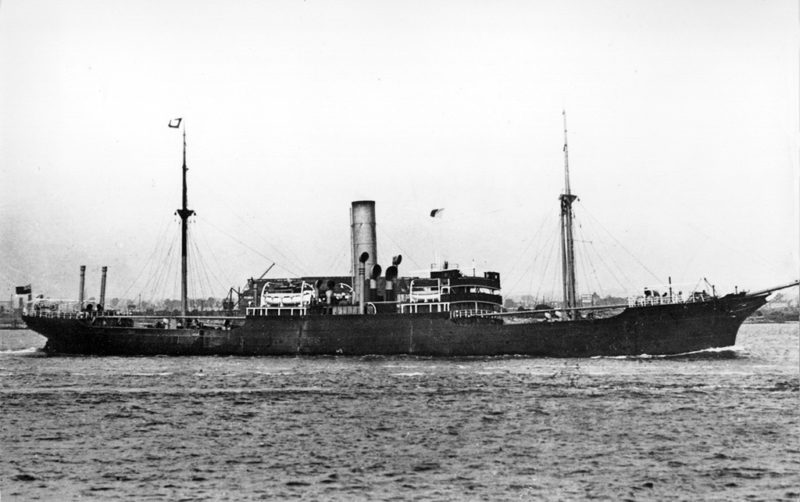
Benlarig of 2,265 grt was completed in 1881 by Alexander Stephen & Sons Ltd. on the Clyde as the first of twenty handsome ‘Leith yachts’ for the Far East trade. She had a bowsprit of length 25 feet complete with figurehead, and her fine raked lines gave a yacht-like appearance when viewed beam-on from a distance. Her crew were mostly Scottish and drawn from around the Edinburgh area, but by the turn of the century had mostly been replaced by Hong Kong Chinese as stewards, painters and in some cases for the whole crew in her sisters. A certain amount of timber was used in her superstructure for doors and fittings on her bridge etc., but the Hong Kong Chinese had a unique way of imitating wood on accommodation bulkheads. This was the painting of panels of artificial light graining enclosed by black stencilled lines in rectangular panels with decoration of Scottish thistles in the four corners, to give a real feel of timber. This practice was unique to the Ben Line fleet and continued through the generations of Hong Kong Chinese crews until the advent of containerisation in 1972.
Killick, Martin & Company were appointed in 1883 as London agents and loading and passenger brokers for the Far East trade. This famous firm of shipbrokers had represented the Thomson interests and dealt with cargo matters for the Far East for a few sailing ships prior to 1871 and for the inaugural voyage of the steamer Benledi of 1871. However, other agents had been used in London for the past twelve years, but the choice was a very good one as they continued to represent Ben Line interests in London for the eastbound voyages for the next 110 years, and on the homeward voyages from 1945.
The fleet consisted of six steamers in 1885 on the Far East berth, and three steamers on the Baltic berth to Reval (Tallinn) in Estonia and St. Petersburg in Russia in summer, and three sailing ships. The sailing ship Benan was wrecked on 23rd December 1888 on Cloate’s Point in Western Australia. It is said that her Master walked into the nearest town clothed in, or dignified by. only a top hat, whether this is authentically true is open to question.
The First William Thomson died in 1889, and on his death the Ben Line fleet had grown to ten steamers and two sailing ships. The steamer Moscow was wrecked off Spain on 16th January 1890 while on a homeward voyage from Italy, having been switched from the Baltic trade during the freeze-up. The last Thomson sailing ship Bencleuch was sold to Italian owners in 1898. The fleet at the turn of the century consisted of ten steamers on the Far East berth and three on the Baltic berth. Benarty of 3,910 grt was the first of nine clipper bowed ships built by Bartram & Sons at Sunderland, she was followed by Benlarig in 1904, Benvenue in 1904, Benledi in 1904, Benlawers in 1905, Benavon in 1905, Bendoran in 1908, Benlomond in 1911, and Benrinnes of 4,791 grt in 1914.
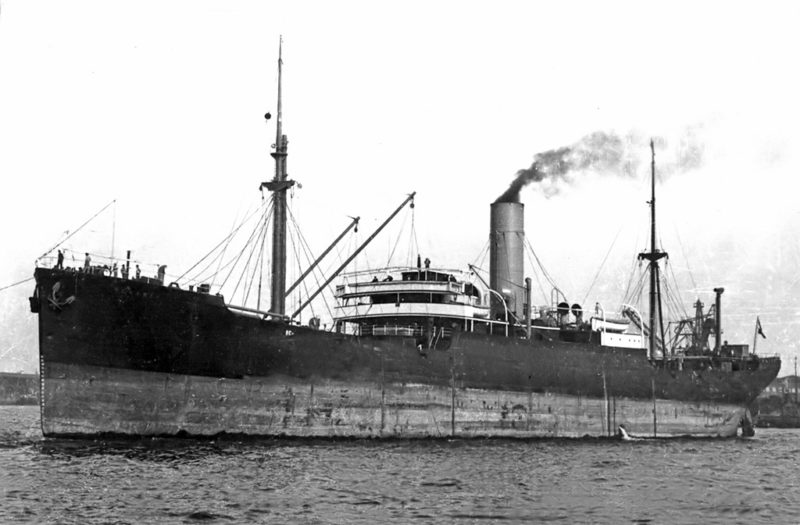
The death of James Wishart Thomson occurred in 1907 aged 66 years, and the death of the second William Thomson in 1911 aged 72 years. On the outbreak of World War I, the Ben Line fleet comprised fourteen clipper-bowed Far East steamers, and another five straight-stemmed steamers on the Baltic berth. Ladoga, Petersburg and Moscow were in Russian territorial waters on the outbreak of war in August, with Ladoga and Moscow later becoming war losses. The full list of war losses was as follows:-
Bengloe – Wrecked on the Moyune Reef in the Philippines on 13th September 1914
Benmhor – Captured by the German cruiser Emden off the South West coast of India and scuttled on 16th October 1914
Benvorlich – Captured and torpedoed and sunk 50 miles south west of Ushant while on a voyage from Manila to London with general cargo by U-28 on 1st August 1915
Ladoga – Torpedoed and sunk in St. George’s Channel 15 miles south east of the South Arklow Light Vessel by UB-73 on 16th April 1918 while on a voyage from Bilbao to Maryport with a cargo of iron ore, 29 crew lost including her Master.
Moscow – Scuttled at Petrograd by the Bolsheviks on 21st October 1918.
Five company vessels had been requisitioned as colliers by the Admiralty and gave good service during the war. The standard War ‘A’ tramp types War Carp and War Roach of 5,225 grt were taken up as colliers on requisition during the second half of 1918.
The Ben Line Steamers Ltd. was formed in 1919, thereby ending ‘one ship accounting’ and the distribution of profits at the end of each voyage to the holders of shares in each ship, much to the detriment of reserves. The first directors were Sir James Wishart Thomson, William Thomson III, Henry Thomson, Edward Thomson, and Alexander Mitchell of Alloa. The fleet consisted of eleven steamers of 64,500 dwt plus a new ‘A’ type standard steamer completed during the war as Benvorlich. A new trade was the transport of soya beans from Vladivostock to European ports. Henry Thomson resigned from the new company towards the end of the year after a rift with his brother although they remained on speaking terms. Instead, Henry set up as a tramp ship owner operating from his home address in Edinburgh and owning a fleet of up to three tramps at any one time e.g. Bosworth of 6,661 grt built in 1919 and a sister Sithonia (ex Radnorshire) built in 1919 and Orfor, but most became war losses during World War II, and he finally gave up shipowning during the 1950s.
BEN LINE STEAMERS Ltd. 1920-1950
Benreoch of 5,818 grt was completed in December 1921 by Charles Connell & Co. Ltd. at Glasgow, having been launched on 29th September 1921. She had hull dimensions of overall length of 420.0 feet, moulded beam of 54.0 feet, and moulded depth of 30.0 feet and a deadweight of 9,250 tons. She was powered by a quadruple expansion steam reciprocating engine by Dunsmuir & Jackson Ltd. of Glasgow to give a service speed of 12.5 knots. She had eight sisters in Benarty of 1926, Benvenue of 1927, Benmhor of 1928, Bencruachan of 1928, Benwyvis of 1929, Benledi of 1930, Benavon of 1930 and Benlawers of 1930. These sisters were thus completed towards the end of the 1920s decade when trading conditions were far from good, with Ben Line ships carrying tramp cargoes in remote parts of the world, especially in place of non-existent homeward voyages from the Far East. Five second-hand steamers were purchased during the 1920s.
Benreoch of 1921 sailed from the Thames on her maiden voyage with a large cargo of battlefield scrap iron for the Far East, but was rammed on her stern by a Norwegian ship before she left the river. She was forced to turn back and have temporary repairs done in London with permanent repairs done in Japan due to the high British shipyard costs. In 1923, Bengloe ex Ardgoil of 5,318 grt and built in 1918 by William Hamilton & Co. Ltd. at Port Glasgow had a flooded engine room in the Red Sea when the underwater injection valve jammed and ten feet of sea water poured in. A collision mat was placed over the hole to check the flow of water, but the boiler fires had by then been put out, and the pumps below had to be fed with steam from the donkey boiler on deck after they had been fired up. The Third Engineer had to dive into the water in an attempt to clear the appropriate valves, but the wind increased, and thus she needed a tow into Aden by Clan Monroe of Clan Line Steamers Ltd.
In August 1924, Benalder of 4,732 grt and built in 1910 as Kirkdale and purchased in 1919 had to fight a fire in her bunker coal under Capt. J. H. Cole while homeward bound from China via the Panama Canal. The blaze was fought by water from the hoses, but both the Chief Engineer and the Second Engineer were overcome by fumes and had to be hauled back to the weather deck before the fire was put out. Benvorlich was a standard ‘A’ type built in 1919 that came upon the Newfoundland schooner Nancy Lee on 24th October 1924 in distress and it was necessary to send a boat across to take off her crew. Capt. George McMillan, the Chief Officer and the members of the boat crew all received a commemorative medal for rescue work of outstanding gallantry.
Onega was the last of the Baltic steamers to be sold in 1927 when she departed for Japan, and William Thomson & Company then concentrated on the Far East trade. The Great Depression started at the very end of 1929 after a financial crash on Wall Street, and began a major downturn in the Far East trade, aggravated by increased European competition. The fleet of sixteen ships in 1932-Benalder, Benarty, Benavon, Bencleuch, Bencruachan, Bendoran, Bengloe, Benledi, Benmacdhui, Benmohr, Bennevis, Benreoch, Benrinnes, Benvenue, Benvorlich and Benwyvis-continued trading and were not laid up, a remarkable achievement. However, profits were hard hit, and the ships invariably returned via the Pacific from the Far East, with a ballast voyage to Vancouver to load lumber homewards via the Panama Canal. The pay of seafarers and shore staff was cut by 10% in 1932, as well as that of partners, that of a first year cadet being cut to tonly £1.12s.0d per month, and a second year cadet cut to only £3.4s.0d per month.
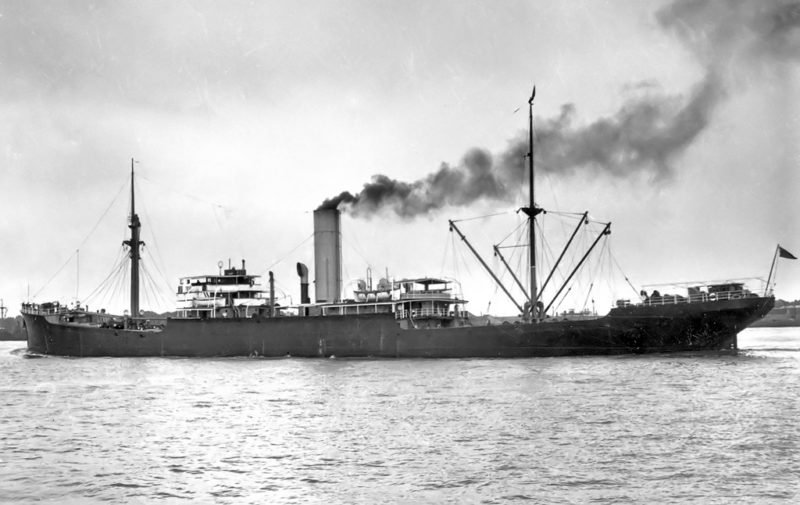
No new ships were completed during the 1930s decade, as the imbalance between eastbound and westbound trade remained a major headache at this time. Many tramp shipowners went bankrupt, and eight second-hand ships were acquired by Ben Line at very low scrapyard prices from banks and mortgage holders. These were:-
Benvannoch purchased in February 1931 when twenty years old, two previous names, sold in November 1935
Bendoran purchased for £6,000 in June 1931 when 21 years old, three previous names, served until used as part of a Mulberry harbour at Arromanches in June 1944
Benmacdhui of 6,869 grt, the biggest in the Ben Line fleet, for £10,000 including dry-docking and equipped for sea, purchased in April 1932, two previous owners, served until she became a war loss.
Benlomond purchased in March 1933 when 19 years old, two previous owners, sold in 1935 to Greek owners.
Benrinnes and her sister Benlomond purchased in 1938 as London Exchange and London Corporation when 17 years old, Benrinnes survived the war and was sold in 1949, Benlomond became a war loss.
Benvannoch and Benvrackie purchased in May 1939 when 18 years old as Dakarian and Darian from T. & J. Harrison of Liverpool, Benvrackie under her first voyage for Ben Line carried 4.25 tonnes of gold bars to the Siamese Government valued at £1.016 million. She then discharged the remainder of her cargo at Hong Kong before sailing in ballast for the beautiful harbour of Newcastle (NSW). She took a course inside the Great Barrier Reef and bent her rudder some degrees to starboard. She loaded a full cargo of iron bars at Newcastle (NSW) to be made into air raid shelters in the U.K. but became a considerable nuisance in convoy on her way home due to erratic steering. Benvannoch survived the war and was sold to Bank Line in 1946, Benvrackie became a war loss.
The first large items of the later lucrative heavy lift trade were carried in 1933. Four aeroplane wings for Imperial Airways were carried to the Suez Canal, and were followed soon afterwards by heavy guns and barrels for the defence of the Seletar Naval Base at Singapore.
This trade developed after World War II into the carriage of heavy and awkward out-of-gauge items such as industrial boilers, stators, rotors, and small craft of all types, which were usually stowed athwartships across the long hatches of a class of four specialist heavy lift ships. Ingenuity was used to bid for cargoes not usually loaded by Ben Line e.g. full cargoes of rice from Ko-Sichang in the Gulf of Thailand, copra from the Philippines, wool from New Zealand ports, sugar from ports in Queensland, soya beans from Dairen in North China, groundnuts from Madras and Cochin in India, and cement in bags to and from various Far East ports.
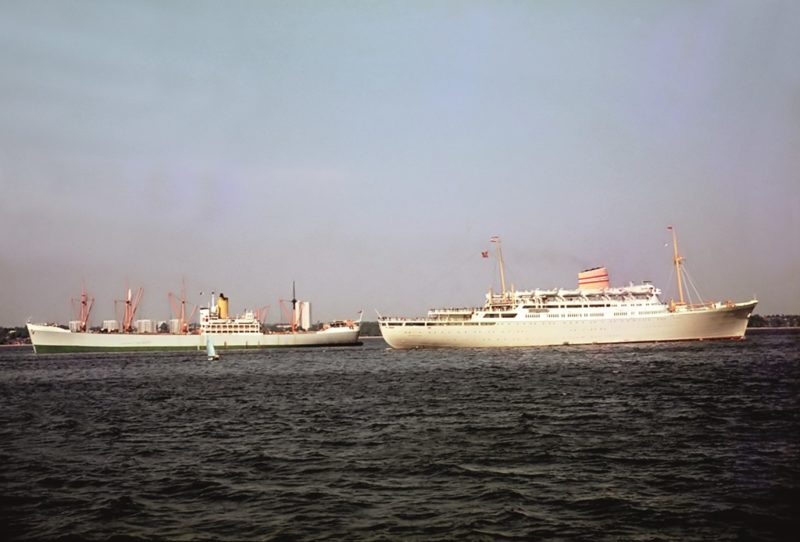
The Ben Line fleet on the outbreak of war in September 1939 consisted of twenty ships of 145,750 dwt, twice that at the end of the Great War. In contrast to the small losses in the earlier war, the Ben Line fleet was almost wiped out in World War II, with fourteen ‘Bens’ and four managed ships sent to the bottom of the sea by the enemy. These are now listed in detail as a reminder of the price and folly of war:-
Benarty- 10.9.1940 captured and scuttled by raider Atlantis in the Indian Ocean
Benavon – 11.9.1940 captured and scuttled by raider Pinguin in the Indian Ocean, 23 lost
Benlawers – 6.10.1940 torpedoed and sunk in the North Atlantic while on a voyage from Swansea to Port Said via Cape Town, 24 lost
Benvorlich – 19.3.1941 bombed and sunk to the West of Malin Head while on a voyage from the Tees to the Far East, 20 lost
Benwyvis – 21.3.1941 torpedoed and sunk to North of Cape Verde Islands while on a voyage from Rangoon and Durban to U.K.
Benvenue – 5.5.1941 torpedoed and sunk 50 miles South West of Freetown while on a voyage from the Tyne to Bombay
Benvrackie – 13.5.1941 torpedoed and sunk 630 miles South West of Freetown while on a voyage from the Tyne to South Africa

Empire Protector – 30.5.1941 torpedoed and sunk off West Africa while on a voyage from Cape Town to Freetown
Bencruachan – 5.7.1941 mined and sunk off Alexandria while on a voyage from Barry with coal
Bennevis – 9.12.1941 captured by Japanese forces off Hong Kong
Bencleuch – 11.12.1941 on fire and abandoned off Cape Farewell while on a voyage from Leith to the Far East via the Panama Canal
Benmacdhui – 21.12.1941 mined and sunk 10 miles ENE of Spurn Head while on a voyage to Hong Kong
Benmhor – 5.3.1942 torpedoed and sunk 235 miles South West of Freetown while on a voyage from Bombay to the Mersey
Fort Qu’Appelle – 17.5.1942 torpedoed and sunk 300 miles off the U.S. Eastern Seaboard on her maiden voyage from Vancouver to U.K.
Benlomond – 23.11.1942 torpedoed and sunk off the Amazon delta while on a voyage from Port Said to Paramaribo via Cape Town, all crew lost except one Chinese steward
Benalbanach – 7.1.1943 sunk by aerial torpedo on her second voyage to North Africa and the Mediterranean packed with troops and ammunition, she sank quickly with an horrendous loss of 410 lives
Fort Babine – 13.9.1943 bombed and sunk off the Portuguese coast, 7 lost
Samvern – 18.1.1945 mined and sunk in the Scheldt estuary while on a voyage from Antwerp to London, 16 lost
In addition, Bendoran was sunk at Arromanches during June 1944 as part of a Mulberry harbour after D-Day. Sir Douglas Thomson had served with the Ministry of War Transport during the war, along with his friend and colleague from Killick, Martin & Company, Percy Rogers. They had been involved with the concept of the ‘MAC’ escort aircraft carrier for the air defence of convoys, and two such ships, Empire Macalpine and Empire Mackendrick were managed by William Thomson & Company during the war. There were only seven survivors from the pre-war fleet at the end of the war, with four of them dating back to before 1921 and unable to steam at more than 12 knots, with Bengloe serving as a coal hulk at Taranto. There was only one new ship, Benlawers of 1944, and she could steam at a relatively fast 15 knots for the 22 days it took to reach Singapore. Fourteen ships had been managed for the Ministry of War Transport in five ‘Empire’ types, three ‘Fort’ types, Ocean Valentine, and five ‘Liberty’ types in Samammla, Samaffric, Samdauntless, Sammont, and Samvern.
The First Newbuilding Programme got underway in 1946 with the purchase of two fast standard cargo-liners of the ‘Fast’ war design joining the fleet as Benvorlich and Bencruachan. In addition, two ‘Ocean’ and five ‘Liberty’ standard war designs also joined the fleet to make up some of the losses. A war standard ‘Heavy Lift’ type was purchased and renamed Benalbanach, and she was followed by three sisters purchased between 1951 and 1956 and renamed as Benledi, Benwyvis and Benarty.
Many of the younger members of these new Ben Line ships saw the regular loading ports in Western Malaya for the first time e.g. Penang (Pulau Pinang), Port Weld, Port Swettenham (Port Kelang and now Port Klang), Port Dickson, Malacca before reaching Singapore. The German prize ship Empire Rani of 7,575 grt was seen by Ben Line ships on 17th April 1947 loading cargo from barges in Penang Roads between Georgetown on Penang Island and Butterworth on the mainland. She had been built in 1921 as Marienfels for Hansa Line of Bremen by J. C. Tecklenborg at Wesermunde and had been captured at Bandar Shapur by British forces on 25th August 1941. Penang Island has beautiful sandy beaches and ferries that run regularly to the Malayan mainland across 1.9 miles of Penang Roads.
The first of the new post-war purpose-built cargo-liners joined the fleet in February 1948 as Benmacdhui of 11,500 dwt, and four sisters were all completed by December 1949 as Benvenue, Bencleuch, Benavon and Benalder. Their impressive array of cargo gear was later added to by the provision of extra posts and derricks on the fo’c’stle. A total of 23 outward sailings and twenty homeward were made during the year as the Far East trade got back into its stride. In October 1949, ten Ben Line ships were due at Hong Kong over the next three months, and a dozen Ben Line ships were due to sail from Hong Kong homewards in the same period.
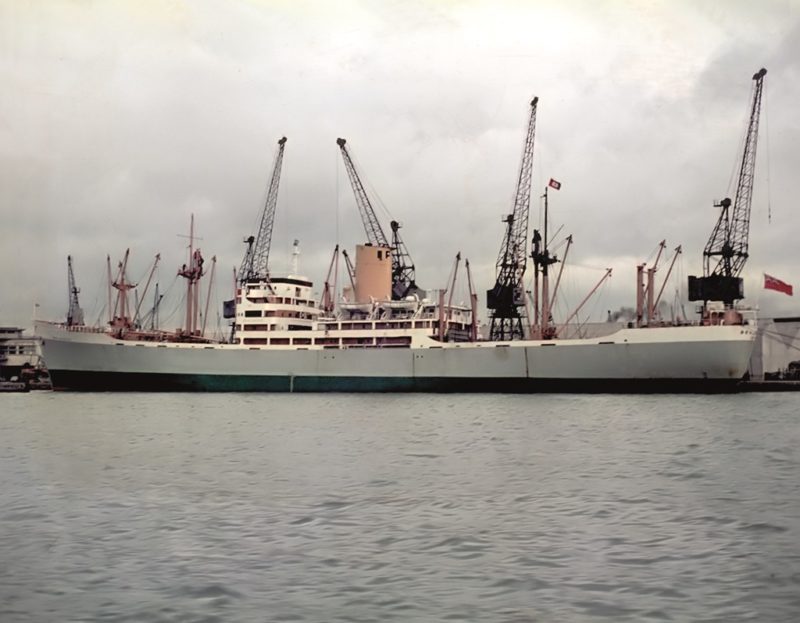
BEN LINE STEAMERS Ltd. 1950-1992
Benledi was lost by fire 150 miles East of Malta on 24th February 1950 on a homeward voyage, no lives were lost and her smoking hulk was later towed into Malta and broken up at La Spezia. In October 1950, ten Ben Line ships were due at Hong Kong via Singapore, and a dozen Ben Line ships were due to sail from Hong Kong for the U.K. The first fleet replacement programme was completed with the purchase of two standard ‘Empire’ tramps built during the war, bringing the fleet back up to its pre-war level. Pegu was also purchased from ‘Paddy’ Henderson and the Burma trade to become Benattow.
The small rice carrier Benveg, which had been chartered during 1950 from Galbraith, Pembroke & Co. Ltd. for use between Bangkok and Singapore, was replaced by the war-built Empire Park and given the same name of Benveg. In 1953, an underwater formation off the north coast of Borneo was named as the ‘Benrinnes Reef’ after the ship that discovered it. Capt. J.S.R. Grassisk noticed that the echo sounder showed a rapidly decreasing depth on a steep curve on the paper recording of depth. This was reported to the Hydrographic Department of the Admiralty asking it to be marked on the charts as the ‘Benrinnes Reef’.
The Silver Line cargo-liner Silveroak joined the fleet in September 1956 as Benvannoch. Silver Line had for many years operated a westwards ‘Round the World’ service across the Pacific to the Far East. A representative of the Prince Line fleet which had a similar service, Javanese Prince, joined the fleet in 1961 as Benlarig. Benvrackie inaugurated the ‘Singapore Star Service’ in 1957 of 22 days voyage time to Singapore, where ships unloaded and loaded over a two week period at the end of the month. This gave shippers particularly in the rubber and forestry trades the possibility of dating bills of lading either in the month of arrival or the month of sailing, whichever they preferred.
Two former escort carriers were purchased in 1957 as Bardic and Gallic and renamed two years later as Bennevis and Benrinnes at the end of their Shaw, Savill & Albion Co. Ltd. charters.
Ben Line Steamers Ltd. had five directors in 1959 in Edward G. Thomson (known universally as ‘Uncle Ted’ and Chairman between 1929 and 1966), Sir Douglas Thomson, James O. Grieve. J. M. (Ian) Miller and Michael Strachan, who were all partners of William Thomson & Company. H. Roderick Macleod was admitted as a partner at the end of the year, and William R. E. Thomson and F.D.D. Thomson (later Sir David Thomson) was admitted in 1963. Michael Strachan became the Chairman of Ben Line between 1970 and 1982, having joined the company as a shipping clerk at the end of 1946. The partnership of William Thomson & Company was wound up in 1964 and all of the partners became directors of the Ben Line Steamers Ltd.
A Ben Line cargo-liner sailed every few days in the 1950s from the Royal Docks on the Thames or East Coast ports in a continuous procession to the Far East laden with British manufactured goods. The Scotstoun yard of Charles Connell & Co. Ltd. on the Clyde launched Benloyal on 3rd October 1958 and completed her as a fast cargo-liner of 11,493 grt and 11,250 dwt in January 1959 and the first Ben Line cargo-liner able to reach Singapore in under twenty days. The fast service was extended to Hong Kong, and the passage time became nineteen days to Singapore and 27 days to Hong Kong, with further extension to Japanese ports. Benloyal was powered by twin Pametrada steam turbines double reduction geared to a single shaft and manufactured by David Rowan & Co. Ltd. of Glasgow with a normal output of 14,000 shaft horse power at 105 rpm at the propeller, but a maximum of 15,500 shaft horse power to give a speed in excess of twenty knots.
Ben Line had a big fleet of 22 cargo-liners of 247,936 dwt at this time, with Benloyal as the twelfth new vessel completed for Ben Line Steamers Ltd., managed by William Thomson and Co. Ltd. of Leith, since the war.
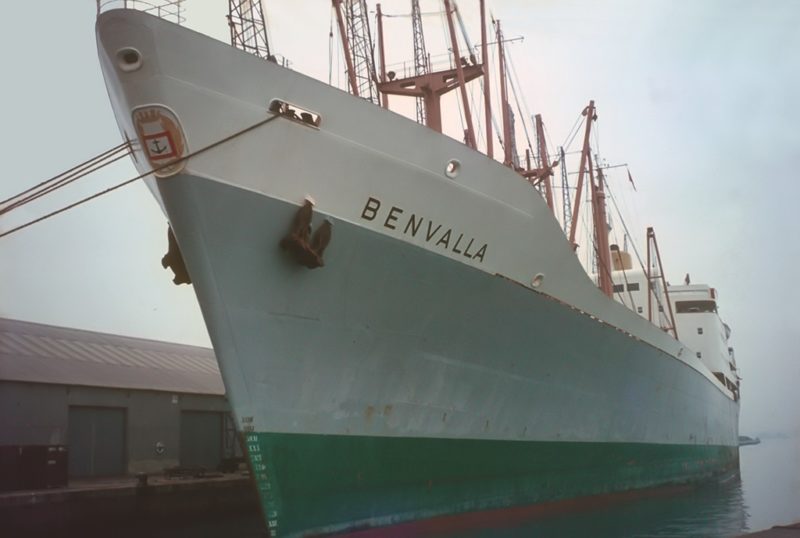
The beautiful furnishings of the passenger public rooms and cabins were chosen by Lady Thomson, wife of Sir Douglas Thomson (Bart), who along with Edward Gordon Thomson, were two of the partners of William Thomson and Co. Ltd. The Dining Room was panelled in dark wood with curtains on either side of the windows, and a portrait of H.M. The Queen above the main table seating nine, with the other diners seated at tables for six, four and two. The Smoking Room was beautifully furnished with dark carpets and the light coloured fabric easy chairs surrounding elegant and slim tables to give a room for relaxation. The four two berth passenger cabins had one side elegantly curved and fitted with a wide window as well as a large dressing table with mirror above, comfortable sofa and easy chairs, and raised beds. The Passenger Lounge was furnished with dark carpets, light coloured fabric easy chairs and comfortable sofas, and elegant occasional tables usually decorated with flowers in tall glass vases. Ventilation and heating to the passenger public rooms and cabins was provided by two units capable of maintaining an even indoor temperature of seventy degrees Fahrenheit via standard punkah louvres.
The trials of Benloyal did not go as well as planned, as when maximum full power was applied for the high speed run, the thrust block seized on the high pressure turbine, necessitating major repairs to the rotor of this turbine. In fact, the newly completed rotor of the high pressure turbine of Bengloe, the second ship of the series, was used for this major repair of replacing the damaged rotor. In addition, five hundred tons of cement ballast was placed in her bottom after her trials to maintain her full stability, and this stability problem was also the reason why the extended forward part of the superstructure above number four hold was dispensed with in her later near sisters.
Ten further fast cargo-liners were built at the Scotstoun yard on the Clyde for Ben Line until the last, Benlawers, was completed in June 1970. Benloyal was joined by three similar but not exact sisters in Bengloe in June 1961, Benvalla in September 1962, and Benarmin in July 1963. Variations on the theme of Benloyal included the number and positioning of Hallen bipod masts and Samson posts, shape of funnels, and length of fo’c’tle and poop, with the extended long bridge deckhouse above number four hold removed in her three later similar vessels. Benvalla and Benarmin were powered by ten cylinder twin single acting Sulzer diesel engines of 15,000 bhp to give their fast service speeds of twenty knots. Bendearg of June 1964 and her improved later sister Benstac of January 1968 introduced a five hold five hatch fast type with the superstructure moved to the ‘three quarters aft’ position to give four clear holds forward served by eighteen derricks including a 75 ton heavy lift derrick.
The heavy lift ship Benarty with a 180 ton Stulcken derrick was completed by the Caledon yard at Dundee in February 1963. She was very much the creation of Edward G. Thomson, who had supervised all of her design, and she was registered under his personal company of E. G. Thomson (Shipping) Ltd. She replaced the quartet of war design heavy lifters which were sold off during 1962/64.
Benledi was the first of a new class of three fast cargo-liners of 13,785 dwt when she was completed at Scotstoun in June 1965, followed by her sisters Benwyvis in December 1966 and Benalbanach in July 1967. The trio were developed from the Benloyal design, and were powered by nine cylinder Sulzer diesels manufactured by the nearby Barclay, Curle yard to give 20,700 bhp and service speeds of 21.5 knots. Benledi made her fastest outward voyage to Singapore in only 16 days, 15 hours and 53 minutes to the anchorage off the port. Their four holds and five hatches, the aft hatch being small and just behind the funnel, were served by ten derricks including a heavy lift derrick of 75 ton capacity, and six electric cranes. They carried a dozen passengers, and had refrigerating capacity and tanks for the carriage of latex. Their principal measurements were length of 563.0 feet and thus fourteen feet longer than Benloyal, moulded beam of 75.0 feet and thus four feet wider than Benloyal, and a loaded draft of 34.0 feet, and thus four feet deeper than Benloyal.
The fast 21.5 knot service speeds of the Benledi trio came in very useful after the closure of the Suez Canal in October 1967, but the much longer voyages via the Cape of Good Hope necessitated the purchase of Ellerman Line and P. & O. cargo-liners to help out with the longer voyage times to and from the Far East.
The last pair of fast Ben Line cargo-liners from the Scotstoun yard were Bencruachan of 14,890 dwt in September 1968, and Benlawers of 14,750 dwt in June 1970. This pair featured part container capacity, with six derricks and six electric cranes on Bencruachan, and only two derricks and six cranes on Benlawers, but all able to lift containers. Bencruachan was twin funnelled with the funnels side by side and connected by a steel stay between them, she suffered the indignity of losing her propeller on the measured mile off Arran during her full power speed trials. When Benlawers was delivered, she joined a much bigger Ben Line fleet of 33 cargo-liners, however very large container ships were on order for the TRIO container service to the Far East of British, German and Japanese shipping companies.
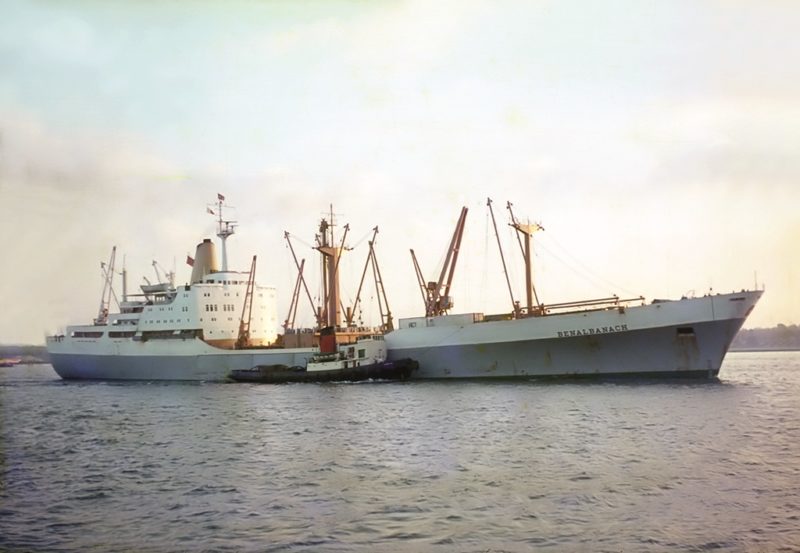
Benlawers had an overall length of 600 feet, moulded beam of 82 feet, and moulded depth of 31 feet, with a service speed of 21.5 knots from a nine cylinder Sulzer diesel engine of 26,100 bhp at 122 rpm. She had a cargo capacity of 1.02 million cubic feet bale with five holds, four forward of the machinery spaces and one aft. She could carry 135 TEU of containers under deck and 57 TEU on deck. The handling of palletised cargo was done by forklifts passing through four large shell doors, each measuring 17.0 feet by 12.0 feet extending from the third deck level to just below the upper deck. All of her decks were specially strengthened and a number of bulkheads have been omitted at second deck level to help the forklifts make the best rates of loading and unloading. She had four cargo elevators serving the ‘tween decks in the main holds, and was fitted with seven cargo tanks of total capacity 50,120 cubic feet for edible oils and latex, and four special compartments for carrying fruit, fish and refrigerated cargo. Accommodation for a dozen passengers was situated at the fore part of the Upper Bridge Deck comprising three excellent double berth, and six single berth cabins, together with a lounge, cocktail bar, and screened swimming pool.
Benalbanach inaugurated the new Japan Star Service on 17th July 1969 from London to Yokohama via Panama and the Pacific on a regular 28 day voyage. Faster ships had provided an alternative to the much longer Cape Town route resulting from the prolonged closure of the Suez Canal. Ben Line ships had not been seen in the Pacific since the 1930s, when they had often taken voyage and time charters from South America or Australia and New Zealand via the Panama Canal. Round voyage times on the Singapore Star Service and Japan Star Service were short, whereas the early post-war Ben Line ships called at many West Malayan and Far East ports to give longer round voyage durations.
Ben Line Containers (BLC) was formed in March 1970 with 80% ownership to Ben Line, and 20% ownership to Ellerman Line, and some twenty large container ships were to be built for the TRIO consortium of British, German and Japanese lines by 1977. Benalder, Benavon, and City of Edinburgh (renamed Benarty in 1992) of 3,00 TEU capacity and 50,000 dwt, OCL (5) ships, Hapag Lloyd (5) ships, NYK (4) ships and Mitsui OSK (3) ships made up this important new fleet. Competition was provided by Continental and Far East lines in the ScanDutch Consortium formed in April 1972, and by the Ace Consortium formed in 1975.
This also signalled the impending ‘beginning of the end’ for the relatively new fleet of eleven twenty knot cargo-liners from the Scotstoun yard. The Benledi trio were sold off to Italia Line in October 1972 to be renamed as Da Noli, Da Recco and Da Verrazano, and Benvalla and Benarmin were sold off to the China Ocean Shipping Corporation (COSCO) at the same time to become Yichun and Yong Chun respectively. Yong Chun was dry docked at Wallsend for the change of ownership, and was later broken up in China in October 1992. Yichun was renamed Hua Chun in 1977 and was broken up in Jiangsu in China in 1985. However, Benloyal, Bengloe, Bendearg, Benstac, Bencruachan and Benlawers sailed on for Ben Line.
Bencruachan needed the fitting of a new bow at the RDM yard in Rotterdam after being hit by a freak wave on 3rd May 1973. Capt. Sinclair was on his last voyage before retiring when she sailed from Singapore, but had to divert to Medan in Sumatra to land a sick crew member with appendicitis, and also to Colombo for bunkers. She was thus behind schedule and was travelling at 21 knots in a heavy gale some 100 miles north east of Durban at 2015 hours when she was hit by a rogue wave of up to one hundred feet in height. She went deep into the wave and the weight of the water on the fo’c’stle dislocated the bow for up to 40 metres of the fo’c’stle. The actual point where the bow folded was a tank full of latex, which remained watertight and probably saved the ship. The impact with the wave was so severe that her Foster Wheeler boiler was forced back almost three inches in the engine room. The bow damage was severe, with number one hold torn open and her bow fractured and drooped downwards by at least eight degrees from the designed position. The passengers were taken off by helicopter to Durban and then flown home, and she was towed into Durban stern first for temporary repairs, and then made her way slowly to Hull for discharge and then on to Rotterdam for permanent repair.
Benloyal arrived at Inchon on 16th June 1978 for breaking up, but her demolition did not begin until six months later in January 1979. Bengloe arrived for breaking up at Hong Kong on 29th July 1978, with Bencruachan aground in the Bitter Lakes in the Suez Canal on 7th August 1978 on a voyage from Liverpool to Yokohama, and it was two weeks later before she was refloated. This left only four in service of the original eleven Scotstoun built twenty knotters in the Autumn of 1978 in Bendearg, Benstac, Bencruachan and Benlawers in Ben Line service. However, Benlawers departed from Ben Line service in October 1978 on her sale to Zepconcorde Inc. of Singapore to become Globe Express.
The final scene of the last trio of this time honoured saga of fast Ben Line cargo-liners sailing for the Far East was played out during 1980/82. Bencruachan was sold for breaking up at Kaohsiung, where she arrived on 3rd May 1980.
Bendearg was sold in April 1981 to Tung Chiao Shipping (Pte) Ltd. of Singapore and was renamed New Panther, and was broken up in China four years later. This left only Benstac in service on her long term charter to Barber Blue Sea for their Round the World service via South American and Far East ports, until she was sold in 1982 to Greek owners and renamed as John P. She lasted only three more years in service, until she sprang a leak on 17th April 1985 400 miles east of Rio Grande while carrying grain, and sank off Southern Brazil in position 32-07 South, 44-08 West around midday. She had severe cracks in the starboard shell plating of the engine room, and her crew of 25 was picked up by the cargo ship Ibn Malik of the United Arab Shipping Company (UASC), which continued on her voyage to Buenos Aires, and where all of the crew of the former Benstac were brought ashore.
Da Recco, the former Benwyvis, was severely damaged by fire on 4th June 1979 while laid up at La Spezia alongside the Italia Line liner Leonardo da Vinci. She was towed clear but was later condemned and broken up locally. Da Noli, the former Benledi, arrived at Chittagong from Constantza on 30th June 1987 as Bello, but ran aground there two months later, and was not finally broken up there until 1993.
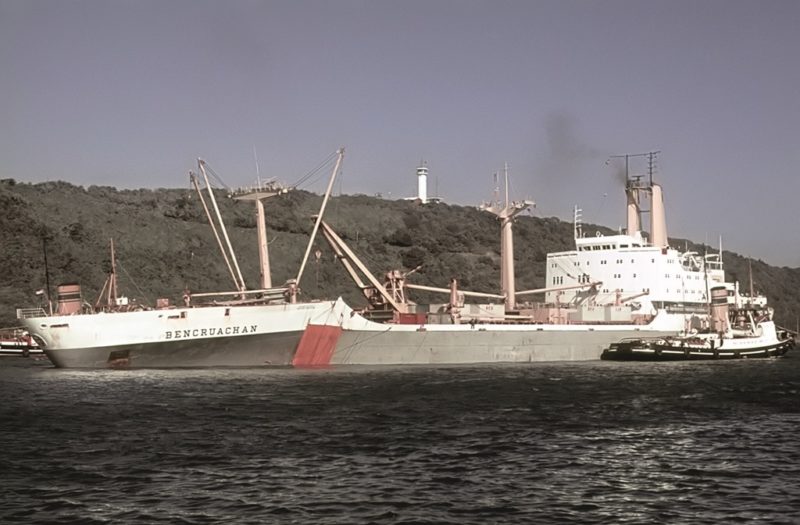
Da Verrazano, the former Benalbanach, was laid up for some time in Piraeus Roads as Bill from June 1987, and was then broken up at Alang in India in October 1988. Benlawers became the Italian livestock carrier Uniceb in 1981 and was employed on the route from Australia to the Persian Gulf, but caught fire in her engine room on 2nd September 1996, with the fire quickly spreading to her accommodation and holds in the Indian Ocean in position 5°12′ South, 65°19′ East, and she foundered soon afterwards.
Important developments had also taken place away from the Far East route. These were:-
(1) Associated Container Transportation (ACT) in January 1966 to serve Australia and New Zealand by Ben Line, Ellerman Line, Blue Star Line, Cunard Line and T. & J. Harrison. Blue Star had the largest shareholding at 42.5%, with all of these companies having been excluded from the 1965 formation of Overseas Containers Ltd. (OCL) by P. & O., Blue Funnel Line, Furness Withy & Co. Ltd., and the British & Commonwealth Shipping Co. Ltd., with each partner having a 25% holding.
(2) Ben Line Ship Management was formed in April 1972 jointly with Galbraith Wrightson Ltd. to manage the new ore/bulk/oil Vianna of 101,450 dwt. Ship management was to become an important part of the Ben Line portfolio.
(3) BEN/EAC Bulk service was formed in 1973 jointly with East Asiatic Company of Denmark for bulk carriers of around 30,000 dwt transporting timber and plywood from Thailand, West Malaysia, Singapore and the Philippines to Europe, and tramping back to the Far East sometimes by a circuitous route. EAC ordered four new bulkers from British and Japanese yards for delivery between 1973 and 1975 with ‘C’ names. Ben Line purchased two second-hand bulkers in 1973, and the service was supplemented by chartered bulkers with each partner making a profit of £2 million in 1974/75. However, the service was terminated in 1979 by mutual consent after losses had been made in 1978.
(4) Ben Odeco Ltd. was formed in March 1974 by Ben Line and the New Orleans based drilling company Ocean Drilling & Exploration Company (Odeco) to prospect for oil with semi-submersible rigs, jack-up rigs and drillships. The rig Ocean Tide built at the John Brown yard at Clydebank in 1971 was taken over by Ben Odeco Ltd. and in the following year a converted C1-M-AV1 wartime engines aft cargo ship joined the company as Ben Ocean Typhoon. Ben Line Offshore Contractors (BLOC) was also formed with partners with expertise in North Sea oil in 1974. A new chemical tanker of 2,580 dwt joined the fleet in December 1974 on charter to BP Chemicals Ltd. for U.K. trading. She was joined by her sisters Benmacdhui in June 1976 and Bencleuch in November 1976.
(5) BenOcean pool of conventional cargo-liners was formed in June 1975 with Blue Funnel Line and managed by Ben Line. The need for conventional tonnage still existed in areas such as the Philippines and Indonesia. Blue Funnel Line had 21 cargo-liners in late 1976, and Bencruachan and others in the Ben Line fleet joined this pool and wore the blue funnel with a black top. The pool was discontinued in 1979.
(6) Ben Asia Container Service (BACS), a feeder container service between Japan, Taiwan, Singapore and West Malaysia was formed in June 1975 on a 12 day frequency in both directions. Ben Line ordered a 426 TEU feeder container ship for the service for delivery in 1979 as Benvalla from Mitsubishi Heavy Industries. Benrinnes was purchased in 1977 from James Fisher & Sons Ltd. of Barrow to operate a similar feeder service between Manila and Hong Kong.
(7) Sheaf Steam Shipping Co. Ltd. of Newcastle was purchased in December 1976 for 115 pence per share, having been founded in 1906 by William Alfred Souter. The Sheaf company from this date were solely managers of ships which, under the terms of the offer, were to carry on for another three or four years under company management before passing to Ben Line. The Panamax bulker Benhope of 71,500 dwt was delivered by Sunderland Shipbuilders Ltd. in April 1978, and formed the Ben Line deep-sea bulker fleet with bulk carriers with ‘Sheaf’ prefixes or ‘Castle’ suffixes to their names e.g. Sheaf Tyne of 52,560 dwt, Sheaf Royal (later Benvorlich) of 38,711 dwt, Alnwick Castle (later Benwyvis) of 118,118 dwt, Ros Castle (later Benledi) of 64,060 dwt, Dunstanburgh Castle of 101,860 dwt, and other bulkers such as Benhiant (ex Cramond) of 28,385 dwt, Benvorlich (ex Ribera) of 29,830 dwt, and Benalbanach (ex Eredine) of 64,060 dwt, and Bennevis (ex Baron Dunmore) of 20,278 dwt. The BEN/EAC bulk service to the Far East from Europe (see above) ran until 1978.
(8) Atlantic Drilling Co. Ltd. was formed in March 1977 from the 50% of a rig venture owned by Sheaf, the other half owned by Cardiff tramp owner Reardon Smith Ltd. The Cardiff half share was later purchased, making Atlantic Drilling, owners of two rigs costing £16 million, the main Ben Line drilling company. Ben Ocean Lancer was completed at this time by Scott Lithgow Ltd. as a sophisticated drillship at a cost of £23 million for world-wide drilling on charter to Chevron.
In February 1980, Ben Line had a big fleet of five container ships, four cargo-liners, six bulk carriers, three chemical tankers, three managed tankers in Grey Hunter, Grey Fighter and Grey Warrior, three drillships in Ben Ocean Lancer, Ben Ocean Typhoon, and Fredericksburg, and three oil rigs.
A new bulker of 150,660 dwt joined the fleet in February 1983 as Bencruachan from a Korean shipyard.
The semi-submersible rig Benreoch of 17,200 tonnes made history in 1984 as being the heaviest rig of its type to be transported on board a semi-submersible carrier, on a voyage from New Zealand to Spain.
BEN LINE ASSOCIATED COMPANIES
- William Thomson & Company
- Atlantis Air Ltd.
- G. Thomson (Shipping) Ltd.
- Elswick Steam Shipping Co. Ltd., Newcastle of Weidner, Hopkins & Company, their steamers had Blue funnels with a black top and a white central band with W. H. & Co. in red split into quarters. All vessels had the prefix ‘Elswick’, with Elswick Manor and Elswick Lodge as war losses in World War I, and Elswick Park missing on her last wartime voyage. A new Elswick Park of 4,188 grt was completed in July 1920 at Blyth, with three ships broken up during the Depression, and their last ship Elswick Park of 1920 was scuttled on 9th June 1944 as part of Gooseberry No. 3 harbour at Normandy
- Salmonier Shipping Co. Ltd. set up by Sir Douglas Thomson in 1947 at St. John’s (NFL) together with his cousins in Newfoundland
- Petrograd Steamers Ltd. formed in 1922 for the Baltic trade and wound up in 1941
- Ben Line Containers Ltd. (1970)
- Ben Ocean & Ben Asia Container Service (1975)
- Ben Odeco offshore drilling partnership (1974)
- Sheaf Steam Shipping Co. Ltd., Newcastle (acquired in 1976)
- Atlantic Drilling Co. Ltd. (1977)
BEN LINE AGENCIES LTD.
During 1992, the last of Ben Line ships including the big container ships Benalder, Benavon and Benarty, and the feeder container ship Maersk Asia Quarto of 7,112 grt and built in 1979, as well as the drillship Benlomond built in 1975, and the oil rigs were sold off, with Ben Odeco Ltd. dissolved, and Diamond-M-Odeco buying a half interest in the rigs. An entry into the ship agency businesses had been pondered for a few years previously, and in 1992 the managers of Ben Line and its stakeholders and the descendants of the original shareholders set up Ben Line Agencies Ltd.
The remit of the new company was to encompass all of the many professional services that agencies can provide to their clients.
- Liner Agents for owners of container ships, multi-purpose vessels and breakbulk ships and PCTC (Pure Car and Truck Carriers).
- Forwarding and Freight Solutions including Transport Management Systems, Bonded Bills of Lading, FCL and LCL Consolidation, Customs clearances, Haulage services, Warehousing and Distribution, Air freight, Cross Border Trucking and a Document Processing Centre.
- Project Logistics to manage time schedules, budgets and the quality of a project.
- Offshore Support and Oilfield Services to manage projects from outset to production stage.
- Marine Agency Services including the traditional Port Agent work.
- Integrated Logistics including ISO Tank Leasing and Chemical logistics for all types of gas, oil and chemical containers, drilling rig companies, oil rig supply vessels, subsea work, scientific surveys, oil and gas exploration, oil block field operators, cable laying, dredging, renewable energy, transportation of goods of all types including heavy lift cargo, infrastructure and shipyard projects.
Ben Line Agencies Ltd. now operate with over two thousand employees in over one hundred offices in Asia including Singapore, Thailand, Japan, Hong Kong, Malaysia (Kemaman and Kluantan), Philippines, Indonesia, China, Myanmar, Vietnam, Cambodia, India, Labuan, South Korea (Seoul and Pusan), Timor-Leste, with an office opened in Vancouver in late 2022 to cover all North American activity on an Asia-Pacific scale. Waterfront Maritime Services was formed in 2017 with partner Sharaf Ship Agencies to give global agency cover, and established the first agency offices outside of Asia in Australia.

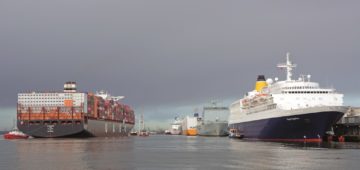



Comments
Sorry, comments are closed for this item